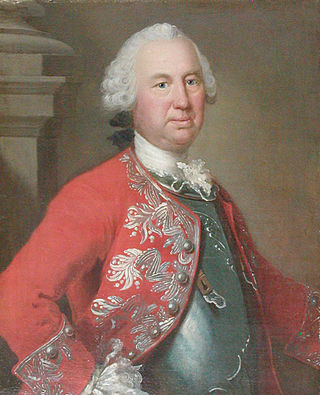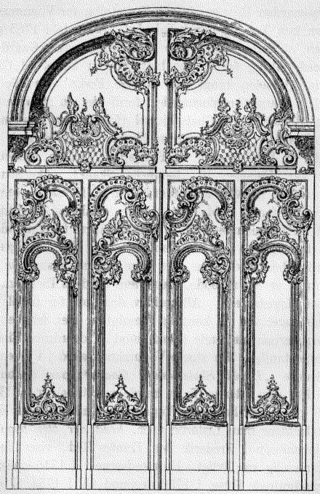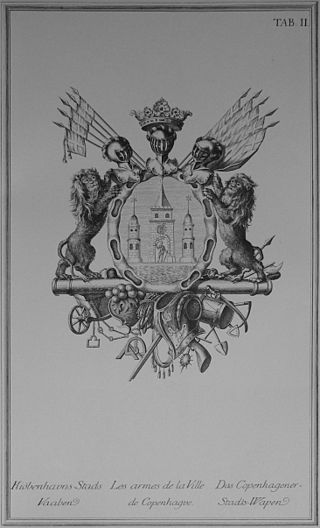The year 1950 in architecture involved some significant architectural events and new buildings.
The year 1788 in architecture involved some significant events.
The year 1817 in architecture involved some significant events.

Christiansborg Palace is a palace and government building on the islet of Slotsholmen in central Copenhagen, Denmark. It is the seat of the Danish Parliament, the Danish Prime Minister's Office, and the Supreme Court of Denmark. Also, several parts of the palace are used by the Danish monarch, including the Royal Reception Rooms, the Palace Chapel and the Royal Stables.
The year 1807 in architecture involved some significant events.
The year 1818 in architecture involved some significant events.

Christian Frederik Hansen, known as C. F. Hansen, was the leading Danish architect between the late 18th century and the mid 19th century, and on account of his position at the Royal Danish Academy of Art the most powerful person in artistic circles for many years. He was known as "Denmark’s Palladio" on account of the architectural style he promoted. His buildings are known for their simplicity, strength and scale.

Laurids Lauridsen de Thurah, known as Lauritz de Thurah, was a Danish architect and architectural writer. He became the most important Danish architect of the late baroque period. As an architectural writer and historian he made a vital contribution to the understanding of both Denmark's architectural heritage and building construction in his day.

Nicolai Eigtved, also known as Niels Eigtved, was a Danish architect. He introduced and was the leading proponent of the French rococo or late baroque style in Danish architecture during the 1730s–1740s. He designed and built some of the most prominent buildings of his time, a number of which still stand to this day. He also played an important role in the establishment of the Royal Danish Academy of Art, and was its first native-born leader.

Caspar Frederik (Friedrich) Harsdorff, also known as C.F. Harsdorff, was a Danish neoclassical architect considered to have been the leading Danish architect in the late 18th century.

Nicolas-Henri Jardin was a French architect. Born in St. Germain des Noyers, Seine-et-Marne, Jardin worked seventeen years in Denmark–Norway as an architect to the Danish royal court. He introduced neoclassicism to Denmark–Norway.
John Palmer was an English architect who worked on some of the notable buildings in the city of Bath, Somerset, UK. He succeeded Thomas Baldwin as City Architect in 1792. He died in Bath.
Thomas Baldwin was an English architect in the city of Bath, who was responsible for designing some of Bath's principal Georgian buildings.

Georg "George" David Anthon was a German-born Danish architect.
Vicko Andrić was a Croatian architect.

Den Danske Vitruvius is a richly illustrated 18th-century architectural work on Danish monumental buildings of the period, written by the Danish Baroque architect Lauritz de Thurah. It was commissioned by Christian VI in 1735 and published in two volumes between 1746 and 1749. The title refers to the Roman architect and engineer Vitruvius, who published De architectura in the 1st century AD, an authoritative treatise on the architecture of the time. The direct inspiration for de Thurah's Den Danske Vitruvius was Colen Campbell's Vitruvius Britannicus.

Marienlyst Castle is a palatial residence located in Helsingør, Denmark. It was named after King Frederik V of Denmark's second wife, Juliana Maria, the queen consort of Denmark and Norway. The building formerly served as a royal pavilion of Kronborg Castle and was mostly used as a venue for pleasure and hunting. It was also used by the director-general of the Øresund Custom House, Colonel Adam Gottlob von Krogh and his wife Magdalene, between 1796 and 1847.

Amaliegade is a street in central Copenhagen, Denmark, which makes up the longer of the two axes on which the Rococo district Frederiksstaden is centred. Amaliegade extends from Sankt Annæ Plads to Esplanaden, passing through the central plaza of Amalienborg Palace on the way where it intersects Frederiksgade, the other, shorter but more prominent, axis of the district.

Bregentved is a manor house located 3 km east of Haslev on the Danish island of Zealand. It has been owned by the Moltke family since the middle of the 18th century.

Frydenlund is a historic house near Vedbæk north of Copenhagen, Denmark.












